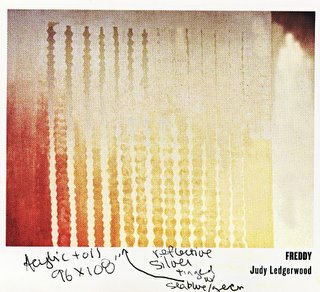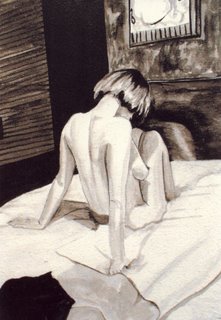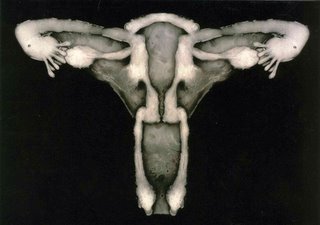An art critique as well as exhibition preview and overview archive spanning from 1999 to 2012 by Mary Lee Pappas, the art critic for the alternative weekly newspaper, NUVO, and visual arts columnist for the daily paper, The Indianapolis Star. Indianapolis, Indiana.
Ad
Thursday, September 27, 2001
Lisa Lynch Habegger - The Bungalow - Sept. 27, 2001 - 3 stars
Habegger paints symmetrical, solid, unadorned vases that project very abstract, harsh shadows. The anthropomorphic donor vessels, sometimes set against little windows with simplistically surreal Mona Lisa landscapes in the distance, look plucked out of a Dali reality - if Dali had been a 15th century Dutch portraitist. This is an analogy, not flattery. "Vessel #6" typifies the verisimilitude and rigid, idealized atmosphere of these glossy oil and acrylic on panel pieces. Perfectly straight horizon lines sharply define the flat, dirt-colored desert foreground that the vessels sit on from the well-coiffed, model train accessory green mountains that cry out, "The hills are alive!" Colors are all true, with no reds in the greens and no greens in the blues. Whatever Habegger is doing, she does well because these pieces are easy to look at and inoffensively pleasing. There is no slight of hand or erroron the artist's part to break the unreal sensation of her landscapes. Through Oct. 4, 2001; 317-251-6028 - Mary Lee Pappas
Thursday, September 20, 2001
"Herron Travels III" - Harrison Centre Gallery - Sept. 20, 2001 - 3 stars
A nice mix of mostly mediocre work from Herron students hangs well in the gallery as testament to recent art education-enhancing travels abroad. The nicest of the nice is a wispy little oil sketch on panel, "The Source," by Christine Blizzard. Priced at a mere $150, it's a bargain-basement price for a painterly prize. A cup bearing a red cross emblem, made in two obvious swift strokes leaving a jagged bristle brush edge, sits upon a counter defined by strong, single sweeps of muddied light blue and yellow-singed grey shadows. Objects on the counter are drawn as murky brown, thin outlines - their color resembling the residue that collects at the bottom of a painter's cup of mineral spirits. Space is defined in concise lines made
with few strokes and with a minimal and dim palette. An obvious scholar of the color wheel, Joseph Sikora's three "La Bois D'Amour Rouge" pieces are, landscapes in black, orange, periwinkle, pinks and reds, swiftly and precisely dappled where the landscape illusion requires it, a green line down a red tree trunk for shadow. Shannon McClane's "The Horse Trainer" is another skillful mentionable. Photos, installation, ceramic sculpture and paintings make up this show that's not really exciting, but not bland either. Through Sept. 26, 2001. 317-920-2494. -Mary Lee Pappas
with few strokes and with a minimal and dim palette. An obvious scholar of the color wheel, Joseph Sikora's three "La Bois D'Amour Rouge" pieces are, landscapes in black, orange, periwinkle, pinks and reds, swiftly and precisely dappled where the landscape illusion requires it, a green line down a red tree trunk for shadow. Shannon McClane's "The Horse Trainer" is another skillful mentionable. Photos, installation, ceramic sculpture and paintings make up this show that's not really exciting, but not bland either. Through Sept. 26, 2001. 317-920-2494. -Mary Lee Pappas
Thursday, September 13, 2001
"White Light" - Herron Gallery - Sept. 13, 2001 - 4 stars

White Light is divine. It accomplishes what it sets out to do, which is to demonsrate the idea of white light as spiritual pure awareness and as an art image itself when light usually only effects the artistic final product. The appropriately named curator, Barry Blinderman, expresses the collective work best in the exhibition brochure. He states, "Light is the oldest and most pervasive visual correlate for attainment and inspiration." All notions of white light (aura, technology and otherworldly) are explored in the works presented. Natural white light is embodied in an untitled photorealistic painting by Jack Goldstein of lightening; while hot solar white light is produced by stepping an a pedal that ignites a blinding 50 light bulb installation by Gregory Green. Two 20-inch-by-20-inch paintings by Christian Garnett resemble eletric currents emitting blue hues -
blue is usually mixed with red/yellow to create electric bulb white light found in the likes of all, arguably uninspirational, color TVs. Two paintings by Susie Rosmarin, one striped and one plaid, mesh multiple spectral colors, generating far-out altered consciousnesslike white light speckles when you close your eyes after viewng. One hundred and twenty prisms, lit by the basic gallery track lighting, rotate slowly producing gentle, bubbling, ghostlike shadows of psychic white light on the gallery walls. Attending this radiantly inspired (pun intended) exhibition, perfectly suited for the Herron Gallery, will enlighten your art consciousness. Through Sept. 29, 2001; 317-920-2420, -Mary Lee Pappas
Phil Campbell "Him and Her" - Hot House Gallery - Sept. 13, 2001 - 3 stars

Campbell's latest work is probably his personal best. A bold light blue wll, demonstrating his shrewd curatorial competency, is a backdrop for 20 intimate 5-inch-by-7-inch nude black and white watercolor portraits of him and girlfriend-muse Jo. A triptych of her inspirational image carries the same rich blue hue. Some images are derived and distorted from digital photos, though they appear to be true to life. A graceful arm branches from an indefinable body and a nude fetal positioned seff-portrait is subtly and paradoxically missing Campbell's head. The clever exclusions are delicate and almost subliminal. The levels of comfort and ease with the paint application are apparent when you investigate the all-in-a-row wall of perfectly aligned tiny nudes. The richness of gray tone is parallel to the softer, more comfortable brushstrokes while the heavier, tighter lines equate to the more severe black/white contrast, The overall treatment is, by and large,dexterous and pretty impressive. Through Oct. 16, 2001; 317-686-0895. -Mary Lee Pappas
"Big White Idea" Mark Sawrie- 4 Star Gallery - Sept. 13, 2001 - 1 1/2 stars

Sawrie uses digital photo techniques to enhance and manipulate his inkjet prints on canvas. The black canvas backgrounds have a soft velvet depth and seem carefully painted. These pieces are executed with practiced, perverted perfection and technical polish. The images (cynical reality meets potentially noxious internal land) are not obviously pleasing, but their disturbing energy is quite overt. They are seemingly absent of provocation and purpose. "Mad Bunny," a Bugs Bunnyish, cartoon-looking, white pigment-based (which means the artists own semen in this case), is a bore. This art is out-of-date if the intention is shock value. All images unemotionally emerge (red and white tones) from a deep void of space with a high contrast of lights and darks. Visit his website at www.moralunderwear.com to view more of his work. Closed Sept. 1, 2001. 317-636-6382. - Mary Lee Pappas
Subscribe to:
Posts (Atom)